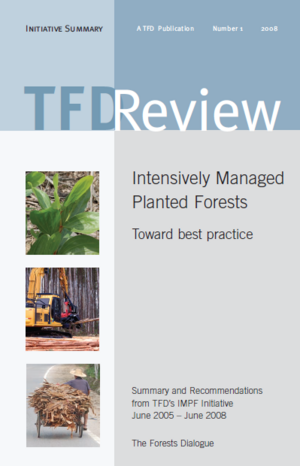TFD Review: Intensively Managed Planted Forests
Intensively-managed planted forests (IMPF) are highly-productive
plantation forests grown primarily for wood and fibre production. There
are currently an estimated 25 M ha of IMPF globally, representing about
a quarter of plantation forests and occupying c. 0.2% of global land area.
IMPF are owned and managed at scales which range from large
corporate estates of hundreds of thousands of hectares, to smallholders
with less than one hectare.
The high productivity of IMPF is such that they contribute disproportionately
– currently around 40% – to the world’s industrial wood supply.
Growing demand for forest products, diminishing supply from natural
forests, and the comparative advantage of IMPF in wood and fibre
production are promoting IMPF expansion, especially of shorter-rotation
IMPF grown primarily for pulpwood. Globally, IMPF expanded at nearly 2%
per year in the first half of this decade – mostly in Asia, Oceania and South
America.
IMPF developments can however be controversial. Proponents
emphasize the economic, employment and infrastructure benefits that
they deliver; critics emphasize the social conflicts and environmental
costs associated with some IMPF. This controversy, and the growing significance
of IMPF, prompted The Forests Dialogue to engage in a IMPF
Dialogue process. This process comprised a Scoping Meeting in 2005,
followed by dialogues and field visits in China (2006), Indonesia (2007)
and Brazil (2008). A total of 143 people participated in the Dialogue
process; representation was balanced across the business, social and environmental
sectors, and 63% of participants were from the global South.
Papers for and reports of each dialogue are available at TFD’s website.
This Review summarises the conclusions and learnings from TFD’s IMPF
Dialogue process. The process sought, firstly, to understand how the
forces driving IMPF expansion were translating into outcomes on the
ground in regions where IMPF expansion is focused and, secondly, to
learn from these about how IMPF projects might best be structured and
implemented to deliver environmental and social, as well as economic,
benefits.

